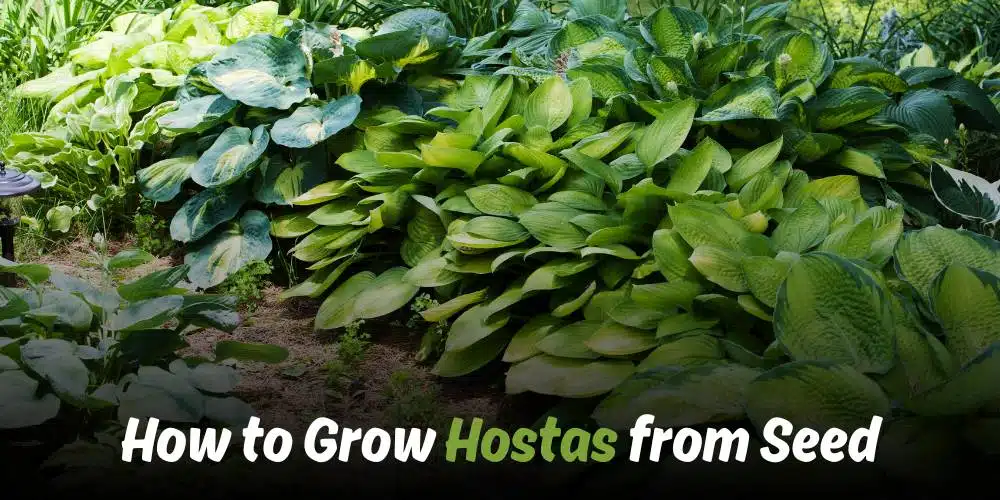Hostas are hardy shade perennials known for their plain green leaves and ability to thrive in large shade areas. Suppose you’re aware that the seeds collected from a parent plant may not always come true to the original variety, like the popular Hosta ‘June’. In that case, you can enjoy experimenting with different seedlings.
Sometimes, growing hostas from seed may result in solid green or all-green reversions, which still make excellent additions to your garden. Sprouting these plants requires patience, as germinated seeds take time, and not every seedling will match the parent plant. However, with the right conditions and a step-by-step guide, you can grow your hosta collection and watch your garden flourish year after year.
How to Grow Hostas from Seed in Simple Steps
Collecting Hosta Seeds
In mid October, as hostas begin their natural cycle, it’s time to collect the seeds. After the flowers have bloomed and the seed pods have formed along the bloom stalk, you’ll notice that these pods will eventually start to change to a green color and feel slightly dry. At this stage, carefully clip the pods from the stalk and store them in a single layer in a cool, dark area to continue drying.


Over the next few weeks, the pods will burst open, revealing tiny black seeds. Once the pods are fully dried, scrape out the seeds and keep them in a cool and dark place until you’re ready for the seed starting month in February. If you want to Save Tomato Seeds for future use, this is the perfect time to do so. With no need for special preparation, these seeds are now ready to be planted and will begin their journey to grow into beautiful, selected plants.
Gathering Your Supplies
- Choose a good-quality potting mix: Opt for a specially formulated seed starting mix to ensure optimal growth.
- Select your containers: Use a variety of containers, such as seed starting trays or plastic drink cups. Make sure they are suitable for starting seeds.
- Ensure proper drainage: Add several holes to your container if it doesn’t already have them. This allows water to escape freely, preventing root rot.
- Provide adequate light: Place your containers in a south-facing window for ample light. If you need more consistent lighting, invest in a grow light.
- Monitor seedling growth: Ensure your seedlings are receiving good light and keep them in a spot with consistent conditions to promote healthy growth.

Planting the Seeds
I’ve found that starting the process in late winter gives your plants the best chance to thrive. Before you begin, ensure your potting mix is thoroughly moistened—it should easily clump together when squeezed in your hand. Scatter the seeds evenly on top of the moistened mix, then cover them lightly with about a 1/8-inch layer of mix. This thin covering is all that’s necessary to encourage germination.

Next, wrap the container with plastic to maintain humidity, which is key for the newly planted seeds. Light isn’t immediately needed, so keep the container in a warm spot where the temperature remains steady. Over the following weeks, you’ll notice the first leaves appear as the seeds begin to gain size.
As the frost date approaches, your seedlings should be ample enough to be transplanted outside when the winter season ends. In my experience, patience during these initial 8 weeks is rewarded with healthy plants that are ready to face the following winter. If you’re curious about How to Grow Zucchini, following these steps will set you on the right path to successful cultivation.
Caring for Seedlings
- Prepare the Location: Choose a suitable location indoors with a stable temperature of around ±20°C. Ensure you have enough space to care for the plants during the growing process.
- Prepare the Potting Mix: Use a soilless potting mix to fill your containers. Make sure the mix stays evenly moist throughout the growth period to provide the best conditions for your seedlings.
- Sow the Seeds: Plant your hosta seeds in the prepared containers. Cover them lightly with the potting mix and, if needed, cover the pots with plastic wrap to maintain moisture.
- Manage Lighting: If the location isn’t naturally bright, use grow lights. These should be positioned about 4-5 inches above the seedlings and left on for 18-24 hours each day to ensure optimal growth.
- Water Properly: After the first leaves appear, remove any plastic covering. Water the plants carefully using a watering can with a sprinkle-type head to avoid overwatering and to keep the soil evenly moist.
- Combat Fungal Diseases: To strengthen the seedlings and combat fungal diseases, place a tabletop fan near the plants and run it on the lowest setting for a couple of hours each day.
- Monitor Growth: Continue to manage the watering, lighting, and overall care of the seedlings as they grow. Though indoor cultivation might be a significant investment and seem difficult, with patience, you can successfully grow strong hostas.

Transplanting into Pots
When your seedlings reach about 2 inches tall, it’s time to transplant them into individual containers. I find that recycled plastic pots work particularly well. Make sure these containers are clean and positioned under bright light to help them continue growing. With proper care, they will soon be 6 inches tall and will have developed several leaves.

Hardening Off Seedlings
Preparing the Seedlings
When it comes to growing hostas from seed, one essential step is hardening off the seedlings. This process is crucial to ensure that your young and tender plants, which have been nurtured in a controlled environment, are ready to face the harsher outdoor conditions.
Gradual Exposure
Begin by moving the containers outside to a location that offers some shade and is protected from strong wind. This transition should be gradual, so start with just a few hours each day and then increase their exposure over several weeks. This approach allows the plants to adapt slowly to the fluctuating temperatures and bright sunlight.
Nighttime Protection
It’s important to move the plants inside at night to prevent any potential shock from cooler temperatures. This careful handling ensures that your hosta plants are well-prepared for their permanent place in the garden, where they can thrive in their new environment.
Transplanting into the Garden
- Grow your seedlings indoors under lights until they are tall and large enough to handle outdoor conditions.
- Once summer arrives and your hostas are ready, move them outside into the garden.
- If your plants are not ready by late fall, keep them inside until the following spring.
- In early spring, uncover the plants and allow them to develop a strong root system as the weather improves.
- For protection against the harsh winter, cover the plants with a layer of straw in late fall to shield them from the cold.
Pollination and Cross-Pollination
For successful pollination, begin by selecting the right cultivar and flower. Remove the stamens and place them on a plate in a dry room or sheltered conditions overnight. By morning, the yellow pollen will be ready. Use small scissors or forceps to carefully extract the stamens and avoid pollinating the flower with its pollen. Store the pollen in a freezer if needed, and make sure to mark the plates with tags so you remember which pollen belongs to which cultivar.

When performing cross-pollination, use a paintbrush to transfer pollen from one flower to the stigma of another. This time-consuming task can yield hybrid varieties. Note the varieties used on tags attached to the flower. After pollination, keep an eye on the caps and pods. Once black seeds form, harvest them, and store them in a warm, dry place until ready to sow. Observing these conditions will help ensure a successful result.
Conclusion
By following proper seed collection, sowing, and care techniques, you can successfully nurture these hardy perennials from tiny seeds to lush, vibrant plants. Although seeds may not always produce exact replicas of the parent plant, the resulting diverse range of hostas can add a unique charm to your garden. With attention to detail in each stage—from collecting seeds to transplanting—the effort can lead to a flourishing garden filled with the beauty of hostas for years to come.
FAQs:
How long does it take hosta to grow from seed?
Hostas are known for their slow growth. At the end of the first growing season, plants will be about 8 inches tall and wide. They will expand in height and width during the second year, eventually reaching maturity in about 4 years. By then, Hostas started from seed will have good growth and will put on even more growth over time.
Can you plant hosta seeds directly in the ground?
Yes, hosta seeds can be sown directly in the ground or pots. Scatter them on the surface without burying them deeply. Ensure proper spacing and light for better germination. If using trays, allow room for each seedling and thin them later if needed.
How do you set hosta seeds?
Collect seeds from dry seed heads in autumn. Sow in small pots with seed compost in spring and place in a cold frame. When seedlings appear, move them to individual pots to grow. Note that seeds from variegated hostas may not be true to their color and might produce plants of just one color.
Can I grow hostas indoors?
Hostas are shade-loving plants in general. This makes them well-suited for indoor growing, where light conditions are usually somewhat dim, especially during the winter months. Sunlight.
What makes hostas grow faster?
To boost the growth of your hostas, including giant hostas, ensure that you enhance water retention in the soil by adding organic matter and peat moss. Water them with about 1 inch of water per week to maximize the chances of developing a massive clump. These simple steps can significantly improve the growing conditions for your plants.

